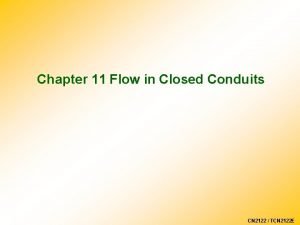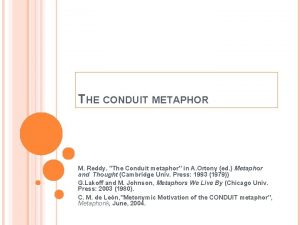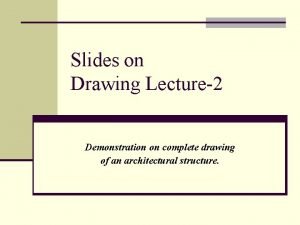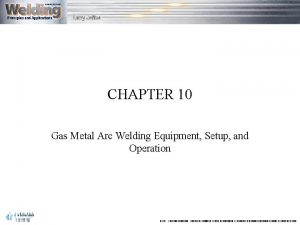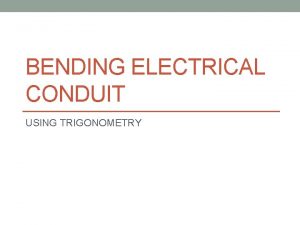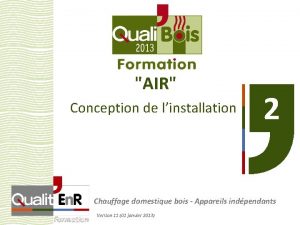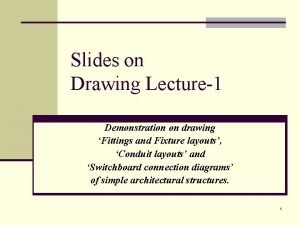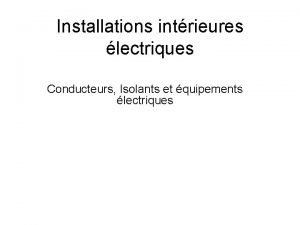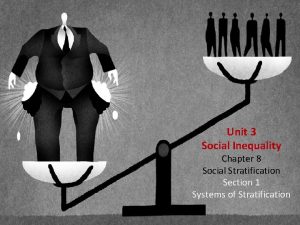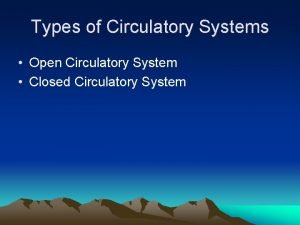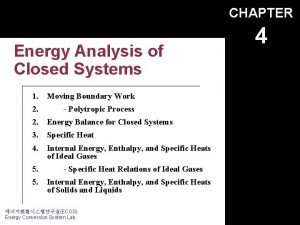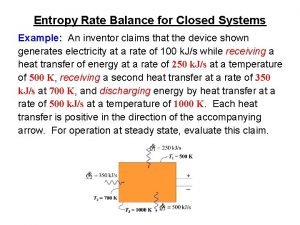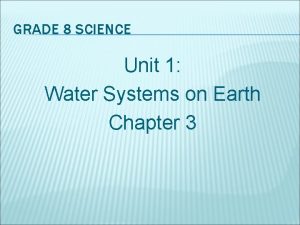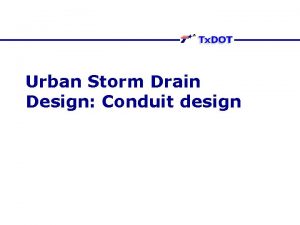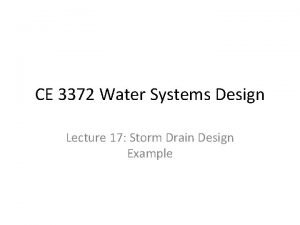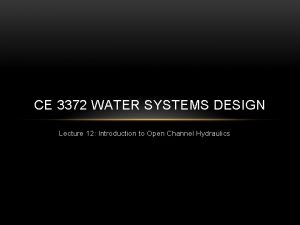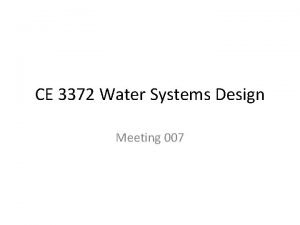CE 3372 Water Systems Design Closed Conduit HydraulicsI

































- Slides: 33

CE 3372 Water Systems Design Closed Conduit Hydraulics-I

Flow in Closed Conduits • Diagram • Energy Equation • Head Loss Models – Pipe loss – Fitting loss • • Moody Chart Problems Direct Method (Jain equations) Branched Systems Looped System

Diagram

Diagram Lift Station Suction Side Discharge Side

Mean Section Velocity • In most engineering contexts, the mean section velocity is the ratio of the volumetric discharge and cross sectional area. • The velocity distribution in a section is important in determining frictional losses in a conduit.

Energy Equation • The energy equation relates the total dynamic head at two points in a system, accounting for frictional losses and any added head from a pump.

Energy Equation 2 1

Head Loss Models • Darcy-Weisbach • Hazen-Williams • Chezy-Mannings

Darcy-Weisbach • Frictional loss proportional to – Length, Velocity^2 • Inversely proportional to – Cross sectional area • Loss coefficient depends on – Reynolds number (fluid and flow properties) – Roughness height (pipe material properties)

Darcy-Weisbach • Frictional loss proportional to – Length, Velocity^2 • Inversely proportional to – Cross sectional area • Loss coefficient depends on – Reynolds number (fluid and flow properties) – Roughness height (pipe material properties)

Darcy-Weisbach • DW Head Loss Equation • DW Equation, Discharge Form, CIRCULAR conduits

Hazen-Williams • Frictional loss proportional to – Length, Velocity^(1. 8) • Inversely proportional to – Cross section area (as hydraulic radius) • Loss coefficient depends on – Pipe material and finish • WATER ONLY!

Hazen-Williams • HW Head Loss • Discharge Form

Hydraulic Radius • HW is often presented as a velocity equation using the hydraulic radius • The hydraulic radius is the ratio of cross section flow area to wetted perimeter

Hydraulic Radius • For circular pipe, full flow (no free surface) AREA D PERIMETER

Chezy-Manning • Frictional loss proportional to – Length, Velocity^2 • Inversely proportional to – Cross section area (as hydraulic radius) • Loss coefficient depends on – Material, finish

Chezy-Manning • CM Head Loss • Discharge form replaces V with Q/A

Fitting (Minor) Losses • Fittings, joints, elbows, inlets, outlets cause additional head loss. • Called “minor” loss not because of magnitude, but because they occur over short distances. • Typical loss model is

Fitting (Minor) Losses • The loss coefficients are tabulated for different kinds of fittings

Moody Chart • Moody-Stanton chart is a tool to estimate the friction factor in the DW head loss model • Used for the pipe loss component of friction

Examples • Three “classical” examples using Moody Char – Head loss for given discharge, diameter, material – Discharge given head loss, diameter, material – Diameter given discharge, head loss, material

Direct (Jain) Equations • An alternative to the Moody chart are regression equations that allow direct computation of discharge, diameter, or friction factor.

Branched System • Distribution networks are multi-path pipelines • One topological structure is branching

Branched System • Node – Inflow = Outflow – Energy is unique value • Links – Head loss along line

Branched System Head loss in each pipe Common head at the node

Branched System Continuity at the node

Branched System • 4 Equations, 4 unknowns • Non-linear so solve by – Newton-Raphson/Quasi. Linearization • Quadratic in unknown, so usually can find solution in just a few iterations

Looped System • Looped system is extension of branching where one or more pipes rejoin at a different node.

Looped System • Nodes: – Inflow = Outflow – Energy Unique • Links – Head loss along pipe – Head loss in any loop is zero LOOP

Examples • Branched System • Loop System

Hydraulic Grade Line • Hydraulic grade line is a plot along a conduit profile of the sum of elevation and pressure head at a location. • It is where a free surface would exist if there were a piezometer installed in the pipeline

Energy Grade Line • Hydraulic grade line is a plot along a conduit profile of the sum of elevation, pressure, and velocity head at a location.

HGL/EGL
 Flow in closed conduits
Flow in closed conduits Rfc 3372
Rfc 3372 Water and water and water water
Water and water and water water Notc symbol
Notc symbol Reddy conduit metaphor
Reddy conduit metaphor Conduit layout diagram
Conduit layout diagram Canal cystique
Canal cystique Electrical raceways and fittings
Electrical raceways and fittings Buried arc transfer definition
Buried arc transfer definition Conduit offset calculator
Conduit offset calculator Dimensionnement des conduits de fumées
Dimensionnement des conduits de fumées Conduit layout drawing
Conduit layout drawing 4 point saddle bend steps
4 point saddle bend steps Estimation and costing electrical
Estimation and costing electrical Conduit par toi celeste guide
Conduit par toi celeste guide Tableau remplissage conduit
Tableau remplissage conduit Ipc in os
Ipc in os Service mesh
Service mesh Electrical conduit
Electrical conduit Open and closed stratification systems
Open and closed stratification systems Do clams have open or closed circulatory systems
Do clams have open or closed circulatory systems Is earth open or closed system
Is earth open or closed system Energy analysis of closed systems
Energy analysis of closed systems Work done in polytropic process
Work done in polytropic process Difference between open and closed system in mis
Difference between open and closed system in mis Entropy balance for closed system
Entropy balance for closed system Decision support systems and intelligent systems
Decision support systems and intelligent systems Engineering elegant systems: theory of systems engineering
Engineering elegant systems: theory of systems engineering Embedded systems vs cyber physical systems
Embedded systems vs cyber physical systems Engineering elegant systems: theory of systems engineering
Engineering elegant systems: theory of systems engineering Water systems grade 8
Water systems grade 8 Wells water systems recently reported
Wells water systems recently reported Fresh and saltwater systems grade 8 test
Fresh and saltwater systems grade 8 test Chapter 15 water and aqueous systems answer key
Chapter 15 water and aqueous systems answer key
